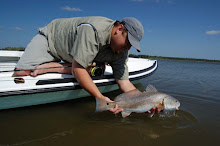GAME FISH INTRODUCED IN NC HOUSE
FINALLY....at long last the North Carolina legislature will vote on a game fish bill.
HB 983 was introduced in the House on Wednesday, April 17, and when it passes will be sent to the Senate for action there.
There is a twist this year. Because of the importance of the legislation to the state's economy, the bill is entitled
2013 Fisheries Economic Development Act.
NOTE: You can visit the NC House of Representatives web site and type in the bill number and read its full contents.
The North Carolina Coastal Conservation Association (CCA) has been sponsoring the legislation for the past three years. The push for a game fish bill was begun four years ago by the Coastal Fisheries Reform Group (CFRG), but that bill was blocked at the committee level by opponents. The following year, the CCA took over as the primary sponsor of the bill, but the effort failed to see the bill introduced once again. Last year, the bill was not introduced because of a threatened veto by then Governor Bev Perdue.
This year, however, the bill will receive a vote. If passed, no longer will the commercial sale of wild caught red drum, spotted sea trout and estuarine striped bass be permitted in North Carolina. Ocean stripers can still be harvested from the beach out to three miles commercially, but that catch is controlled by a quota system. In federal waters from three miles and beyond, stripers cannot be harvested.
Only red drum or specs imported or farm raised can be sold in the state. Restaurants can sell stripers legally taken from the beach out to three miles. Stripers from inshore cannot be sold in the North Carolina once this bill is passed.
The bill is much more inclusive than just game fish status. It contains provisions for increasing
fishing license fees that will bring in much needed revenue to the Division of Marine Resources. It also contains provisions to financially assist commercial fishermen who can prove they have been adversely affected by the bill.
In addition, the bill provides revenue for dredging of some of North Carolina's inlets, valuable avenues for passage to not only commercial vessels, but recreational fishing boats. Many of these inlets are in dire need of dredging since the federal monies previously used for this purpose have dried up. HB 983
does not involve increasing boat registration fees.
In all other states that have either instituted game fish and/or an outright net ban, economic activity has increased. Why? Because as the fish populations, namely red drum and specs to our south, have increased, recreational fishing pressure has increased. Fishermen spend lots and lots of money in pursuit of their favorite recreation. We all know about that.
This has been proven in Texas, Louisiana, Florida and South Carolina. Within the past month, the State of Georgia also designated the red drum a game fish. North Carolina joins Mississippi as the only states from NC to Texas without game fish status for drum and specs.
You can visit the CCA's web site at
http://ccanc.org/ and learn of the economic benefits of the legislation. These economic statistics have largely been compiled from the records of the NC Division of Marine Fisheries.
The CFRG urges all North Carolina residents to contact their NC House Representative and Senator. Ask them to vote for the bill. These members can be obtained by visiting
http://www.ncga.state.nc.us/ At that site click on either House or Senate, then on member lists.
Please be courteous and respectful to these elected officials.
With your assistance, we can finally see some improvements in our fishery. And we can help improve our state's economy.
Thanks and good fishing.









.jpg)








